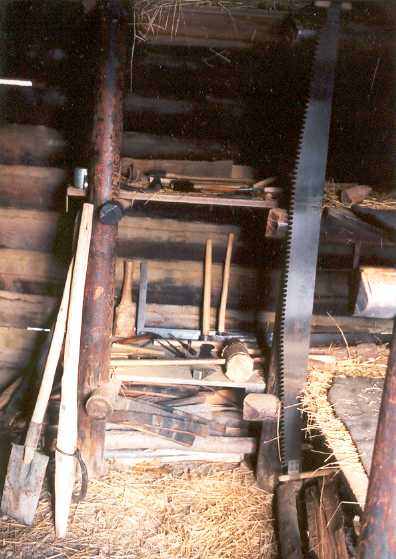Revision
Date: 8/3/2003
Project
Goals & Objectives,
Overview of Initial Work, Living
History & Advancing into the Past, Tools
to Build a Log City, Participating
Soldier Hut Rehabilitation:
Tools to Build a Log City
When Washington's Army was moving out of Valley Forge (late Spring of 1778)
much of the camp equipage that was not immediately needed was
shipped to a post previously established at Morristown NJ. Soon after, James Abeel, the new Deputy Quartermaster General
in charge of Camp Equipage moved himself to that post. For
the next several years Morristown appears to have been the center of his operations.
Fortunately for us, many of the records kept by Abeel and his colleages
have survived. Amongst them is the Receipt book kept by Deputy
Quartermaster General Jacob Weiss for December 1779.
Here was recorded the tools issued for building the log huts and
the names of the Brigade Quartermasters that received them.
Types of tools listed include:
-
axes
-
shovels, picks, spades
-
pairs of rings for mauls, iron wedges
-
log chains, doggs
-
frows
- cross cut saw, hand saws
-
augers, gimlets
-
morticing chisels, gouges
-
compass
-
iron square, box rules, chalk and line
- saw sets, saw files, grindstones & cranks
The receipt books reveal exactly what was issued. Well almost.
Sometimes there are multiple meanings for a given name, and specifics that
were commonly known or unimportant to the storekeeper were not recorded.
We have attempted to recreate the tools by synthsizing research on where
the tools were made, illustrations from the period, surviving typical examples,
and archeological artifacts. The evidence strongly suggests that
most, if not all of the Continental Army tools were either made by the
Army or by civilian contract (as opposed to imported by merchants). It
also appears that the tools issued were to be maintained and basic repairs
made in Camp rather than be sent back to Morristown.


Here a maple log is cut into sections to be used for
maul heads. Pairs of Iron rings made by blacksmiths are then fitted
to the end, and the faces of the maul drilled with a gimlet and then spread
with small wedges. photos courtesy of Arthur Bowie


Boring large diameter holes in what will soon become
mallet heads using a nose auger, the most common type of auger in use during
the American Revolution. Holding the log in position is a log dogg.
A "dogg" is simply a holding device, and the exact type of dogg issued
to the soldiers for hutting is not known, but a log dog like the one shown
at first seemed to be the most logical possibility. However, our need to
maneuver the logs soon suggested that "ring dogs" were more likely what
was meant. A ring dog is a hook and ring that can be used to in pairs
to carry or drag a log, or singly on a long handle to act as a cant hook.
photos M. Grubel NPS (left) Scott Shephard
(right).


Once made, a maul with "pair of iron rings", and iron
wedge make short work splitting up logs. The making of wood wedges
to expand the split and free the iron wedge is a traditional practice.
See some original tools & equipment in Morristown National Historical
Park's on-line Museum
Exhibit
Site Contents:
Project Goals
& Objectives (intro)
Overview of
Inital Work (page 1)
Advancing
into the Past (page 2)
Tools of the
Trade (page 3)
Participating at the Pennsylvania Line (page 4)
For More information Contact :
Mathew Grubel
Note: The project is on indefinate hold as of Dec. 2003
You are still welcome to contact me via direct e-mail here.







